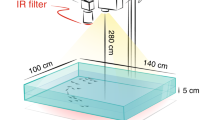Summary
The formation of swarms by planktonic organisms was first described almost 100 years ago, but the mechanisms governing the development of patterns in population size and density are still not understood. In this study, we investigated one biophysical factor that may play an important role in swarm-formation. Spontaneous ultraweak photon emission in the visible range has been well documented for living cells, tissues and individuals in the plant and animal kingdom, including humans. We demonstrate here that the intensity of light emitted by the planktonic crustaceanDaphnia magna is a function of population density in relation to body size. The effects are discussed on the basis of the theory of Dicke1,2, and it is suggested that biophoton emission may be a basic factor in the self-regulation of swarm density.
Similar content being viewed by others
References
Dicke, R. H., Phys. Rev.93 (1954) 99.
Crubellier, R., Liberman, S., and Pillet, D., J. Phys. B., At. molec. Phys.18 (1985) 3811.
Prigogine, I., Nicolis, G., and Babloyantz, A., Physics Today11 (1972) 23.
Haken, H., ed., Dynamics of Synergetic Systems. Springer, Berlin 1980.
Crisp, D. J., Nature193 (1962) 597.
Johnson, D. S., and Chua, T. E., Crustaceana24 (1973) 332.
Popp, F. A., Warnke, U., König, H. L., and Peschka, W., Eds, Electromagnetic Bio-Information. Urban & Schwarzenberg, Munich 1989.
Tembrock, G., Verhaltensbiologie. Harri Deutsch, Frankfurt/Main 1987.
Popp, F. A., et al. (Multi-author Review). Experientia44 (1988) 543.
Popp, F. A., Li, K. H., Mei, W. P., Galle, M., and Neurohr, R., Experientia44 (1988) 576.
Popp, F. A., Ruth, B., Bahr, W., Böhm, J., Groß, P., Grolig, G., Rattemeyer, M., Schmidt, H. G., and Wulle, P., Collective Phenomena3 (1981) 187.
Santhram, K. R., Navaneethakrishnan, P., and Krishnaswamy, S., Arch. Hydrobiol.80 (1977) 398.
Brandl, Z., and Fernando, C. H., Can. J. Zool.49 (1971) 775.
Colebrook, J. M., J. Animal Ecol.29 (1960) 241.
Ratzlaff, W., Limnol. Oceanogr.19 (1974) 993.
Van Wijk, R., and Schamhart, D., Experientia44 (1988) 586.
Scholz, W., Staszkiewics, U., Popp, F. A., and Nagl, W., Cell Biophys.13 (1988) 55.
Tsong, T. Y., Trends Biochem. Sci.14 (1989) 89.
Galle, M., Ph. D. Thesis. Universität Saarbrücken, Fachbereich Zoologie, 1991, in preparation.
Author information
Authors and Affiliations
Rights and permissions
About this article
Cite this article
Galle, M., Neurohr, R., Altmann, G. et al. Biophoton emission fromDaphnia magna: A possible factor in the self-regulation of swarming. Experientia 47, 457–460 (1991). https://doi.org/10.1007/BF01959943
Received:
Accepted:
Published:
Issue Date:
DOI: https://doi.org/10.1007/BF01959943




